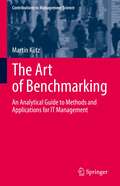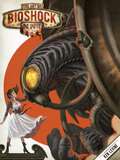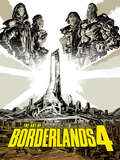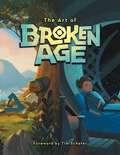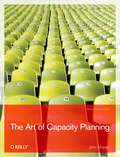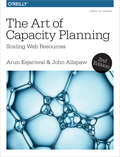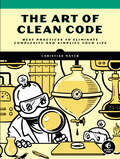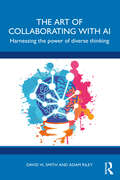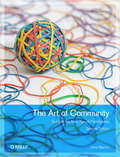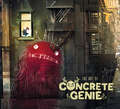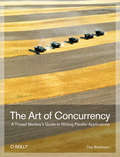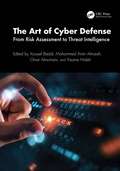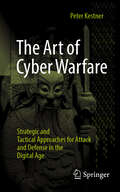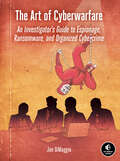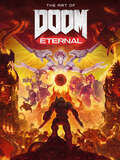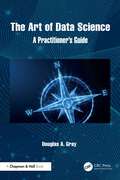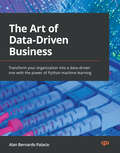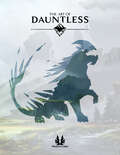- Table View
- List View
The Art of Benchmarking: An Analytical Guide to Methods and Applications for IT Management (Contributions to Management Science)
by Martin KützBenchmarking is considered a must for modern management. This book presents an approach to benchmarking that has a solid mathematical basis and is easy to understand and apply. The book focuses on three main topics. It shows how to formalize the representation of benchmarking objects. Furthermore, it presents different methods from decision making and voting and their application to benchmarking. Finally, it discusses suitable features for different benchmarking objects. The objects considered are taken from IT management, but can be easily transferred to other business areas, which makes the book interesting for all practitioners in the management field.
The Art of Bioshock Infinite
by Julian MurdochIn The Art of BioShock Infinite, delve deeper into the city of Columbia—the fabled floating metropolis that serves as a beacon of technology and achievement for the early 1900s! This deluxe hardcover features production designs and concept illustrations focusing on main characters Booker DeWitt, Elizabeth, and Songbird from the BioShock Infinite video game. See the evolution of Sky-Hooks, Heavy Hitters, the populace of Columbia, Vigors, airships, and much more! * BioShock Infinite won over 75 video game awards, including Best Original Game and Best of Show! * Introduction by creative director Ken Levine.
The Art of Black and White Photography
by Torsten Andreas HoffmannOver the last few years, most books on photography have been focused on the new breed of cameras and how to master the digital imaging workflow. In The Art of Black and White Photography author and photographer Torsten Andreas Hoffmann takes a different approach, focusing on image composition and image capture, with an emphasis on the creative aspects of black and white photography rather than on the digital workflow. After introducing the ground rules of composition, Hoffmann illustrates their applications with his own stunning black and white images that cover various photographic genres, including architecture, street photography, portraiture, and surreal photography. Also discussed are the elements of a "photographic language"', which distinguishes creative photography from random shooting. Finally, you will learn valuable post-processing techniques, mostly using Photoshop, that emphasize the functions necessary for creating outstanding black and white images. This second edition has been updated to include Photoshop CS5, as well as brand new images, content, and a revised layout.
The Art of Borderlands 4
by Rick BarbaA full-color oversized hardcover volume collecting art and commentary chronicling the development of Borderlands 4! Borderlands 4 brings intense action, badass Vault Hunters, and billions of wild and deadly weapons to an all-new planet ruled by a ruthless tyrant.In Gearbox Entertainment and 2K&’s next entry of their iconic looter shooter franchise, the cataclysmic arrival of Pandora&’s moon throws the planet Kairos into chaos, and only the Vault Hunters and their allies will be able to stop the authoritarian machinations of the Timekeeper.You&’re invited to join Gearbox, 2K, and Dark Horse for a deep dive into the making of Borderlands 4, from concepts to character designs, enemies to environments. And of course, guns! See how the world of Kairos came together in The Art of Borderlands 4!
The Art of Broken Age
by VariousWith Broken Age, adventure gaming auteur Tim Schafer returned for the first time in 16 years to the genre that he helped create, and after a historic, record-breaking crowdfunding campaign, the full adventure is here in all its beautiful, hand-painted glory! Now, Dark Horse Books is proud to partner with Double Fine Productions to offer an intimate look into the worlds of Broken Age! Featuring hundreds of pieces of art, and commentary from the notable voices of director Tim Schafer, lead artist Nathan "Bagel" Stapley, concept artists Peter Chan and Scott Campbell, art director Lee Petty, and more!
The Art of CRM: Proven strategies for modern customer relationship management
by Max FatouretchiThis CRM masterclass gives you a proven approach to modern customer relationship managementKey FeaturesProven techniques to architect CRM systems that perform well, that are built on time and on budget, and that deliver value for many yearsCombines technical knowledge and business experience to provide a powerful guide to CRM implementationCovers modern CRM opportunities and challenges including machine learning, cloud hosting, and GDPR complianceBook DescriptionCRM systems have delivered huge value to organizations. This book shares proven and cutting-edge techniques to increase the power of CRM even further.In The Art of CRM, Max Fatouretchi shares his decades of experience building successful CRM systems that make a real difference to business performance.Through clear processes, actionable advice, and informative case studies, The Art of CRM teaches you to design successful CRM systems for your clients.Fatouretchi, founder of Academy4CRM institute, draws on his experience over 20 years and 200 CRM implementations worldwide.Bringing CRM bang up to date, The Art of CRM shows how to add AI and machine learning, ensure compliance with GDPR, and choose between on-premise, cloud, and hybrid hosting solutions.If you’re looking for an expert guide to real-world CRM implementations, this book is for you.What you will learnDeliver CRM systems that are on time, on budget, and bring lasting value to organizationsBuild CRM that excels at operations, analytics, and collaborationGather requirements effectively: identify key pain points, objectives, and functional requirementsDevelop customer insight through 360-degree client view and client profilingTurn customer requirements into a CRM design specArchitect your CRM platformBring machine learning and artificial intelligence into your CRM systemEnsure compliance with GDPR and other critical regulationsChoose between on-premise, cloud, and hybrid hosting solutionsWho this book is forCRM practitioners who want to update their work with new, proven techniques and approaches
The Art of Capacity Planning
by John AllspawSuccess on the web is measured by usage and growth. Web-based companies live or die by the ability to scale their infrastructure to accommodate increasing demand. This book is a hands-on and practical guide to planning for such growth, with many techniques and considerations to help you plan, deploy, and manage web application infrastructure.The Art of Capacity Planning is written by the manager of data operations for the world-famous photo-sharing site Flickr.com, now owned by Yahoo! John Allspaw combines personal anecdotes from many phases of Flickr's growth with insights from his colleagues in many other industries to give you solid guidelines for measuring your growth, predicting trends, and making cost-effective preparations. Topics include:Evaluating tools for measurement and deployment Capacity analysis and prediction for storage, database, and application servers Designing architectures to easily add and measure capacity Handling sudden spikes Predicting exponential and explosive growth How cloud services such as EC2 can fit into a capacity strategy In this book, Allspaw draws on years of valuable experience, starting from the days when Flickr was relatively small and had to deal with the typical growth pains and cost/performance trade-offs of a typical company with a Web presence. The advice he offers in The Art of Capacity Planning will not only help you prepare for explosive growth, it will save you tons of grief.
The Art of Capacity Planning: Scaling Web Resources
by John AllspawSuccess on the web is measured by usage and growth. Web-based companies live or die by the ability to scale their infrastructure to accommodate increasing demand. This book is a hands-on and practical guide to planning for such growth, with many techniques and considerations to help you plan, deploy, and manage web application infrastructure. The Art of Capacity Planning is written by the manager of data operations for the world-famous photo-sharing site Flickr.com, now owned by Yahoo! John Allspaw combines personal anecdotes from many phases of Flickr's growth with insights from his colleagues in many other industries to give you solid guidelines for measuring your growth, predicting trends, and making cost-effective preparations. Topics include: * Evaluating tools for measurement and deployment, * Capacity analysis and prediction for storage, database, and application servers, * Designing architectures to easily add and measure capacity, * Handling sudden spikes, * Predicting exponential and explosive growth, * How cloud services such as EC2 can fit into a capacity strategy. In this book, Allspaw draws on years of valuable experience, starting from the days when Flickr was relatively small and had to deal with the typical growth pains and cost/performance trade-offs of a typical company with a Web presence. The advice he offers in The Art of Capacity Planning will not only help you prepare for explosive growth, it will save you tons of grief.
The Art of Capacity Planning: Scaling Web Resources in the Cloud
by John Allspaw Arun KejariwalIn their early days, Twitter, Flickr, Etsy, and many other companies experienced sudden spikes in activity that took their web services down in minutes. Today, determining how much capacity you need for handling traffic surges is still a common frustration of operations engineers and software developers. This hands-on guide provides the knowledge and tools you need to measure, deploy, and manage your web application infrastructure before you experience explosive growth.In this thoroughly updated edition, authors Arun Kejariwal (MZ) and John Allspaw provide a systematic, robust, and practical approach to capacity planning—rather than theoretical models—based on their own experiences and those of many colleagues in the industry. They address the vast sea change in web operations, especially cloud computing.Understand issues that arise on heavily trafficked websites or mobile appsExplore how capacity fits into web/mobile app availability and performanceUse tools for measuring and monitoring computer performance and usageTurn measurement data into robust forecasts and learn how trending fits into the planning processExamine related deployment concepts: installation, configuration, and management automationLearn how cloud autoscaling enables you to scale your app’s capacity up or down
The Art of Clean Code: Best Practices to Eliminate Complexity and Simplify Your Life
by Christian MayerLearn eight principles to simplify your code and become a more effective (and successful) programmer.Most software developers waste thousands of hours working with overly complex code. The eight core principles in The Art of Clean Coding will teach you how to write clear, maintainable code without compromising functionality. The book&’s guiding principle is simplicity: reduce and simplify, then reinvest energy in the important parts to save you countless hours and ease the often onerous task of code maintenance.Bestselling author Christian Mayer leverages his experience helping thousands perfect their coding skills in this new book. With expert advice and real-world examples, he&’ll show you how to: Concentrate on the important stuff with the 80/20 principle -- focus on the 20% of your code that matters mostAvoid coding in isolation: create a minimum viable product to get early feedbackWrite code cleanly and simply to eliminate clutter Avoid premature optimization that risks over-complicating code Balance your goals, capacity, and feedback to achieve the productive state of FlowApply the Do One Thing Well philosophy to vastly improve functionalityDesign efficient user interfaces with the Less is More principleTie your new skills together into one unifying principle: Focus The Python-based The Art of Clean Coding is suitable for programmers at any level, with ideas presented in a language-agnostic manner.
The Art of Coding: The Language of Drawing, Graphics, and Animation
by Theodor Wyeld Mohammad Majid al-Rifaie Anna UrsynAs the title suggests, this book explores the concepts of drawing, graphics and animation in the context of coding. In this endeavour, in addition to initiating the process with some historical perspectives on programming languages, it prides itself by presenting complex concepts in an easy-to-understand fashion for students, artists, hobbyists as well as those interested in computer science, computer graphics, digital media, or interdisciplinary studies. Being able to code requires abstract thinking, mathematics skills, spatial ability, logical thinking, imagination, and creativity. All these abilities can be acquired with practice, and can be mastered by practical exposure to art, music, and literature. This book discusses art, poetry and other forms of writing while pondering difficult concepts in programming; it looks at how we use our senses in the process of learning computing and programming. Features: Introduces coding in a visual way Explores the elegance behind coding and the outcome Includes types of outcomes and options for coding Covers the transition from front-of-classroom instruction to the use of online-streamed video tutorials Encourages abstract and cognitive thinking, as well as creativity The Art of Coding contains a collection of learning projects for students, instructors and teachers to select specific themes from. Problems and projects are aimed at making the learning process entertaining, while also involving social exchange and sharing. This process allows for programming to become interdisciplinary, enabling projects to be co-developed by specialists from different backgrounds, enriching the value of coding and what it can achieve. The authors of this book hail from three different continents, and have several decades of combined experience in academia, education, science and visual arts. Source Code: The source code for the book can be accessed here.
The Art of Collaborating with AI: Harnessing the Power of Diverse Thinking
by Adam Riley David VL SmithWe are at a momentous inflection point in our evolutionary history: generative AI is becoming mainstream, transforming the world of work, and specifically that of knowledge workers. This book helps you to navigate your upskilling journey to remain relevant and to add value in the workplace.Knowledge workers must face up to the fact that there is a need to urgently reboot their skill set to survive and thrive in the new AI era. Many of the historic competences and points of differentiation that employees could offer are being challenged with AI technology. This book is all about building the power skills that knowledge workers will need to develop to maintain a competitive edge and work effectively alongside AI. It’s a future where AI will now do a lot of the heavy lifting and one in which employers will increasingly be looking for people to add value in areas where AI is weak. In particular, this puts the spotlight on the need for workers to dial up their potential as polymaths. These are people who can see the big picture from different perspectives and who can add that extra layer of innovative thinking and creativity to everything they do. Importantly, the book provides a framework for understanding how AI is likely to reshape the fundamental structure of the workforce, and how knowledge workers can strategically position themselves to enhance their value.This book provides an essential guide to developing new skill sets for knowledge workers in the AI era. Not only does it ensure that you don’t fall behind, it will also enable you to succeed and thrive.
The Art of Community: Building the New Age of Participation
by Jono BaconOnline communities provide a wide range of opportunities for supporting a cause, marketing a product or service, or building open source software. The Art of Community helps you recruit members, motivate them, and manage them as active participants. Author Jono Bacon offers experiences and observations from his 14-year effort to build and manage communities, including his current position as manager for Ubuntu.Discover how your community can become a reliable support network, a valuable source of new ideas, and a powerful marketing force. This expanded edition shows you how to keep community projects on track, make use of social media, and organize collaborative events. Interviews with 12 community management leaders, including Linus Torvalds, Tim O’Reilly, and Mike Shinoda, provide useful insights.Develop specific objectives and goals for building your communityBuild processes to help contributors perform tasks, work together, and share successesProvide tools and infrastructure that enable members to work quicklyCreate buzz around your community to get more people involvedHarness social media to broadcast information, collaborate, and get feedbackUse several techniques to track progress on community goalsIdentify and manage conflict, such as dealing with divisive personalities
The Art of Community: Building the New Age of Participation (Theory in Practice)
by Jono BaconOnline communities offer a wide range of opportunities today, whether you're supporting a cause, marketing a product or service, or developing open source software. The Art of Community will help you develop the broad range of talents you need to recruit members to your community, motivate and manage them, and help them become active participants. Author Jono Bacon offers a collection of experiences and observations from his decade-long involvement in building and managing communities, including his current position as manager for Ubuntu, arguably the largest community in open source software. You'll discover how a vibrant community can provide you with a reliable support network, a valuable source of new ideas, and a powerful marketing force.The Art of Community will help you:Develop a strategy, with specific objectives and goals, for building your communityBuild simple, non-bureaucratic processes to help your community perform tasks, work together, and share successesProvide tools and infrastructure that let contributors work quicklyCreate buzz around your community to get more people involvedTrack the community's work so it can be optimized and simplifiedExplore a capable, representative governance strategy for your communityIdentify and manage conflict, including dealing with divisive personalities
The Art of Concrete Genie
by PixelOpusWalk among the mysterious streets of Denska and collect the real pages of artwork behind PixelOpus' endearing video game Concrete Genie!This art book studies the power of self-expression, creativity and the game's core fantasy of making anyone believe they can be an artist - just like the talented protagonist of the game, Ash. Return to the characters, monsters, and lore of Denska to uncover the secrets behind PixelOpus' 'living paint' mechanics that allow the walls of Denska to come to life with player creations. Witness a special, behind-the-scenes look at the development of Concrete Genie from the small and passionate team that brought it to life.From the developers of a truly empowering journey about oppression and creativity, Dark Horse Books and PixelOpus are delighted to present The Art of Concrete Genie! This art book collects heart-warming, magnificent illustrations for fans of Ash and his wildly varied 'living paint' creations within Concrete Genie.
The Art of Concurrency: A Thread Monkey's Guide to Writing Parallel Applications
by Clay BreshearsIf you're looking to take full advantage of multi-core processors with concurrent programming, this practical book provides the knowledge and hands-on experience you need. The Art of Concurrency is one of the few resources to focus on implementing algorithms in the shared-memory model of multi-core processors, rather than just theoretical models or distributed-memory architectures. The book provides detailed explanations and usable samples to help you transform algorithms from serial to parallel code, along with advice and analysis for avoiding mistakes that programmers typically make when first attempting these computations.Written by an Intel engineer with over two decades of parallel and concurrent programming experience, this book will help you:Understand parallelism and concurrencyExplore differences between programming for shared-memory and distributed-memoryLearn guidelines for designing multithreaded applications, including testing and tuningDiscover how to make best use of different threading libraries, including Windows threads, POSIX threads, OpenMP, and Intel Threading Building BlocksExplore how to implement concurrent algorithms that involve sorting, searching, graphs, and other practical computationsThe Art of Concurrency shows you how to keep algorithms scalable to take advantage of new processors with even more cores. For developing parallel code algorithms for concurrent programming, this book is a must.
The Art of Cuphead
by Studio MDHRGet transported back to the golden age of 1930s animation with an art book celebrating the acclaimed run & gun game, Cuphead!Each page of this curated collection of artwork is designed to capture the vintage look and feel of the 1930's. Take a gander at the game's traditional hand-drawn frame-by-frame animation. Peek at the early concepts, production work, and early ideas that went into the making of Cuphead's characters, bosses, stages and more including never-before-seen content from the upcoming DLC! Relive the most cherished and challenging moments of Cuphead and Mugman's adventure to reclaim their souls from The Devil, all in a way you've never seen before! Guided by personal insights from game directors Chad and Jared Moldenhauer, take a one-of-a-kind trip through the Inkwell Isles and discover an all-new appreciation for Cuphead's animation style and challenging retro gameplay.Dark Horse Books and Studio MDHR are thrilled to present The Art of Cuphead! This vintage-style art extravaganza is the perfect book for fans of Cuphead!
The Art of Cyber Defense: From Risk Assessment to Threat Intelligence (Advances in Cybersecurity Management)
by Yassine Maleh Youssef Baddi Mohammed Amin Almaiah Omar AlmomaniThe Art of Cyber Defense: From Risk Assessment to Threat Intelligence offers a comprehensive exploration of cybersecurity principles, strategies, and technologies essential for safeguarding digital assets and mitigating evolving cyber threats. This book provides invaluable insights into the intricacies of cyber defense, guiding readers through a journey from understanding risk assessment methodologies to leveraging threat intelligence for proactive defense measures.Delving into the nuances of modern cyber threats, this book equips readers with the knowledge and tools necessary to navigate the complex landscape of cybersecurity. Through a multidisciplinary approach, it addresses the pressing challenges organizations face in securing their digital infrastructure and sensitive data from cyber‑attacks.This book offers comprehensive coverage of the most essential topics, including: Advanced malware detection and prevention strategies leveraging artificial intelligence (AI) Hybrid deep learning techniques for malware classification Machine learning solutions and research perspectives on Internet of Services (IoT) security Comprehensive analysis of blockchain techniques for enhancing IoT security and privacy Practical approaches to integrating security analysis modules for proactive threat intelligence This book is an essential reference for students, researchers, cybersecurity professionals, and anyone interested in understanding and addressing contemporary cyber defense and risk assessment challenges. It provides a valuable resource for enhancing cybersecurity awareness, knowledge, and practical skills.
The Art of Cyber Warfare: Strategic and Tactical Approaches for Attack and Defense in the Digital Age
by Peter KestnerThe Art of Cyber Warfare explores the strategic and tactical approaches for offense and defense in the digital age. Drawing on historical conflicts from Sun Tzu to Carl von Clausewitz, the author illustrates that, despite changed conditions such as time, location, means, and resources – but not the laws of physics – it is possible to learn from past actions and reactions.The author aims to demonstrate in this book that, in reality, we have only transferred old methods into our current era but have forgotten to translate their reasons, effects, and the resulting lessons. For, as it has been for thousands of years, the reasons for human-created conflicts remain the same: wealth, fame, power, honor, or desire. Can we learn something from history for present and future (cyber) wars?
The Art of Cyberwarfare: An Investigator's Guide to Espionage, Ransomware, and Organized Cybercrime
by Jon DiMaggioA practical guide to understanding and analyzing cyber attacks by advanced attackers, such as nation states.Cyber attacks are no longer the domain of petty criminals. Today, companies find themselves targeted by sophisticated nation state attackers armed with the resources to craft scarily effective campaigns. This book is a detailed guide to understanding the major players in these cyber wars, the techniques they use, and the process of analyzing their advanced attacks. Whether you&’re an individual researcher or part of a team within a Security Operations Center (SoC), you&’ll learn to approach, track, and attribute attacks to these advanced actors. The first part of the book is an overview of actual cyber attacks conducted by nation-state actors and other advanced organizations. It explores the geopolitical context in which the attacks took place, the patterns found in the attackers&’ techniques, and the supporting evidence analysts used to attribute such attacks. Dive into the mechanisms of: • North Korea&’s series of cyber attacks against financial institutions, which resulted in billions of dollars stolen • The world of targeted ransomware attacks, which have leveraged nation state tactics to cripple entire corporate enterprises with ransomware • Recent cyber attacks aimed at disrupting or influencing national elections globallyThe book&’s second part walks through how defenders can track and attribute future attacks. You&’ll be provided with the tools, methods, and analytical guidance required to dissect and research each stage of an attack campaign. Here, Jon DiMaggio demonstrates some of the real techniques he has employed to uncover crucial information about the 2021 Colonial Pipeline attacks, among many other advanced threats. He now offers his experience to train the next generation of expert analysts.
The Art of DOOM: Eternal
by Bethesda Softworks ID SOFTWAREA full-color digital art book containing concept art and commentary from the development of DOOM Eternal, the next entry in the iconic first-person shooter series.The newest chapter in the quintessential game franchise from id Software is here. Witness DOOM Eternal! This epic volume explores the art and development of the hotly anticipated sequel to the 2016 Game Award-winner for Best Action Game! Explore the twisted demonic invasion of Earth, the cultist UAC facilities, and plunge into otherworldly and unknown locations new to the DOOM universe. Admire the dangerous glimmering edges of the Slayer's arsenal and armor. Examine the ancient designs and breeds of Hell's soldiers and lords--all in gloriously designed full color images straight from the files of the game's artists themselves! Dark Horse Books and id Software join forces to present The Art of DOOM Eternal, encompassing every detail you've come to love from DOOM!
The Art of Data Analysis
by Kristin H. JarmanA friendly and accessible approach to applying statistics in the real worldWith an emphasis on critical thinking, The Art of Data Analysis: How to Answer Almost Any Question Using Basic Statistics presents fun and unique examples, guides readers through the entire data collection and analysis process, and introduces basic statistical concepts along the way.Leaving proofs and complicated mathematics behind, the author portrays the more engaging side of statistics and emphasizes its role as a problem-solving tool. In addition, light-hearted case studies illustrate the application of statistics to real data analyses, highlighting the strengths and weaknesses of commonly used techniques. Written for the growing academic and industrial population that uses statistics in everyday life, The Art of Data Analysis: How to Answer Almost Any Question Using Basic Statistics highlights important issues that often arise when collecting and sifting through data. Featured concepts include:* Descriptive statistics* Analysis of variance* Probability and sample distributions* Confidence intervals* Hypothesis tests* Regression* Statistical correlation* Data collection* Statistical analysis with graphsFun and inviting from beginning to end, The Art of Data Analysis is an ideal book for students as well as managers and researchers in industry, medicine, or government who face statistical questions and are in need of an intuitive understanding of basic statistical reasoning.
The Art of Data Science: A Practitioner's Guide
by Douglas A. GrayAlthough change is constant in business and analytics, some fundamental principles and lessons learned are truly timeless, extending and surviving beyond the rapid ongoing evolution of tools, techniques, and technologies. Through a series of articles published over the course of his 30+ year career in analytics and technology, Doug Gray shares the most important lessons he has learned – with colleagues and students as well – that have helped to ensure success on his journey as a practitioner, leader, and educator.The reader witnesses the Analytical Sciences profession through the mind’s eye of a practitioner who has operated at the forefront of analytically inclined organizations, such as American Airlines and Walmart, delivering solutions that generate hundreds of millions of dollars annually in business value, and an educator teaching students and conducting research at a leading university. Through real‑world project case studies, first‑hand stories, and practical examples, we learn the foundational truth underlying successful analytics applications. From bridging theory and practice, to playing a role as a consultant in digital transformation, to understanding how analytics can be economically transformational, identifying required soft skills like leadership skills, and understanding the reasons why data science projects often fail, the reader can better visualize and understand the nuanced, multidimensional nature of Analytical Sciences best practices, projects, and initiatives.The readers will gain a broad perspective on where and how to find success with Analytical Sciences, including the ability to ensure that we apply the right tool, at the right time and right place, and sometimes in different industries.Finally, through the author’s own career synopsis on becoming a practitioner and leader, and his distilled insights, the reader is offered a view into the future that analytics holds, along with some invaluable career advice regarding where to focus, how to make good choices, and how to measure success individually and organizationally.
The Art of Data-Driven Business: Transform your organization into a data-driven one with the power of Python machine learning
by Alan Bernardo PalacioLearn how to make the right decisions for your business with the help of Python recipes and the expertise of data leadersKey FeaturesLearn and practice various clustering techniques to gather market insights Explore real-life use cases from the business world to contextualize your learningWork your way through practical recipes that will reinforce what you have learnedBook DescriptionOne of the most valuable contributions of data science is toward helping businesses make the right decisions. Understanding this complicated confluence of two disparate worlds, as well as a fiercely competitive market, calls for all the guidance you can get.The Art of Data-Driven Business is your invaluable guide to gaining a business-driven perspective, as well as leveraging the power of machine learning (ML) to guide decision-making in your business. This book provides a common ground of discussion for several profiles within a company.You'll begin by looking at how to use Python and its many libraries for machine learning. Experienced data scientists may want to skip this short introduction, but you'll soon get to the meat of the book and explore the many and varied ways ML with Python can be applied to the domain of business decisions through real-world business problems that you can tackle by yourself. As you advance, you'll gain practical insights into the value that ML can provide to your business, as well as the technical ability to apply a wide variety of tried-and-tested ML methods.By the end of this Python book, you'll have learned the value of basing your business decisions on data-driven methodologies and have developed the Python skills needed to apply what you've learned in the real world.What you will learnCreate effective dashboards with the seaborn libraryPredict whether a customer will cancel their subscription to a serviceAnalyze key pricing metrics with pandasRecommend the right products to your customersDetermine the costs and benefits of promotionsSegment your customers using clustering algorithmsWho this book is forThis book is for data scientists, machine learning engineers and developers, data engineers, and business decision makers who want to apply data science for business process optimization and develop the skills needed to implement data science projects in marketing, sales, pricing, customer success, ad tech, and more from a business perspective. Other professionals looking to explore how data science can be used to improve business operations, as well as individuals with technical skills who want to back their technical proposal with a strong business case will also find this book useful.
The Art of Dauntless
by Phoenix LabsMaster the hunt and forge your legend!Dauntless is a fresh take on the action-RPG genre, developed by industry veterans from Riot Games, BioWare, and other acclaimed studios. After a cataclysmic event, mankind survives in a harsh, yet majestic world of floating islands. Ferocious beasts known as Behemoths now stalk the earth. You are a Slayer, an elite warrior who risks life and limb hunting the Behemoth threat. On your journey, you'll forge an extraordinary arsenal of weapons and gear to overcome formidable challenges threatening our survival. Now, you have a unique opportunity to witness the creation of this magnificent epic like never before.Dark Horse Books and Phoenix Labs are thrilled to present the most intimate look at the development of the game with The Art of Dauntless, a meticulously curated tome full of hundreds of pieces of concept art each paired with exclusive commentary from the team that created it. You won't want to miss this unique opportunity to experience the Shattered Isles in a whole new way!
